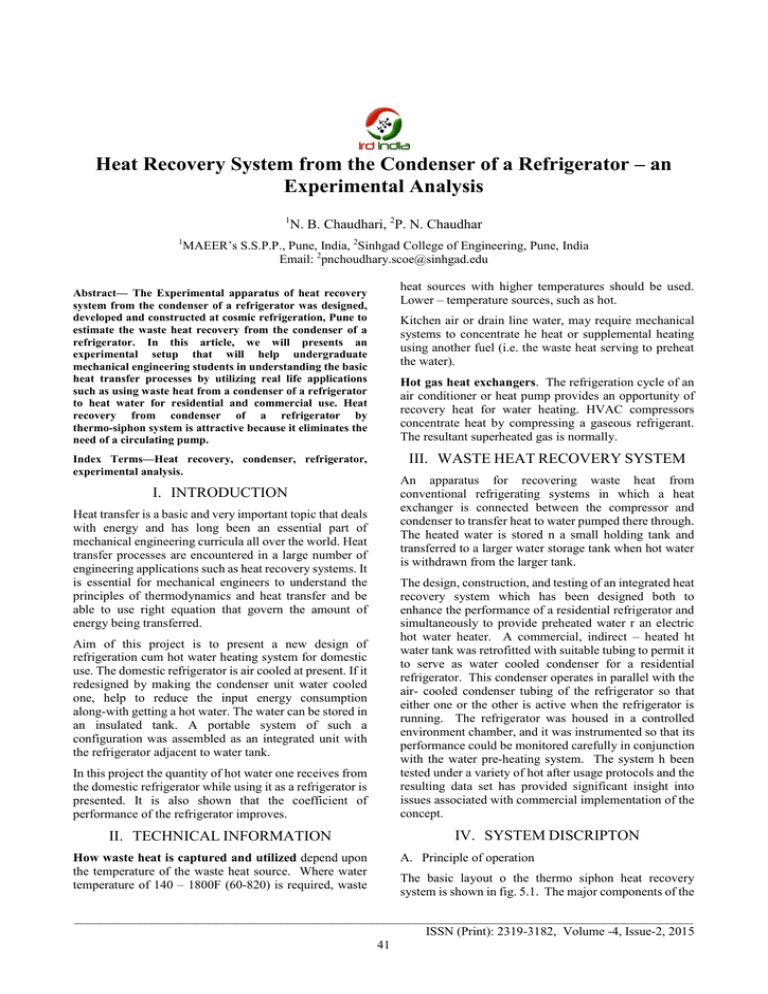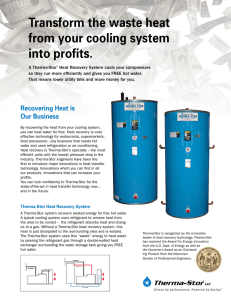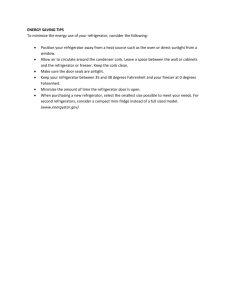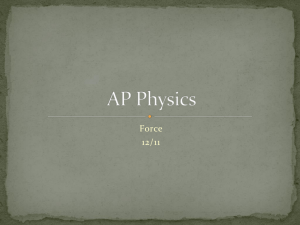Heat Recovery System from the Condenser of a
advertisement

International Journal on Theoretical and Applied Research in Mechanical Engineering (IJTARME) _______________________________________________________________________________________________ Heat Recovery System from the Condenser of a Refrigerator – an Experimental Analysis 1 N. B. Chaudhari, 2P. N. Chaudhar 1 MAEER’s S.S.P.P., Pune, India, 2Sinhgad College of Engineering, Pune, India Email: 2pnchoudhary.scoe@sinhgad.edu Abstract— The Experimental apparatus of heat recovery system from the condenser of a refrigerator was designed, developed and constructed at cosmic refrigeration, Pune to estimate the waste heat recovery from the condenser of a refrigerator. In this article, we will presents an experimental setup that will help undergraduate mechanical engineering students in understanding the basic heat transfer processes by utilizing real life applications such as using waste heat from a condenser of a refrigerator to heat water for residential and commercial use. Heat recovery from condenser of a refrigerator by thermo-siphon system is attractive because it eliminates the need of a circulating pump. Index Terms—Heat recovery, condenser, refrigerator, experimental analysis. I. INTRODUCTION Heat transfer is a basic and very important topic that deals with energy and has long been an essential part of mechanical engineering curricula all over the world. Heat transfer processes are encountered in a large number of engineering applications such as heat recovery systems. It is essential for mechanical engineers to understand the principles of thermodynamics and heat transfer and be able to use right equation that govern the amount of energy being transferred. heat sources with higher temperatures should be used. Lower – temperature sources, such as hot. Kitchen air or drain line water, may require mechanical systems to concentrate he heat or supplemental heating using another fuel (i.e. the waste heat serving to preheat the water). Hot gas heat exchangers. The refrigeration cycle of an air conditioner or heat pump provides an opportunity of recovery heat for water heating. HVAC compressors concentrate heat by compressing a gaseous refrigerant. The resultant superheated gas is normally. III. WASTE HEAT RECOVERY SYSTEM An apparatus for recovering waste heat from conventional refrigerating systems in which a heat exchanger is connected between the compressor and condenser to transfer heat to water pumped there through. The heated water is stored n a small holding tank and transferred to a larger water storage tank when hot water is withdrawn from the larger tank. In this project the quantity of hot water one receives from the domestic refrigerator while using it as a refrigerator is presented. It is also shown that the coefficient of performance of the refrigerator improves. The design, construction, and testing of an integrated heat recovery system which has been designed both to enhance the performance of a residential refrigerator and simultaneously to provide preheated water r an electric hot water heater. A commercial, indirect – heated ht water tank was retrofitted with suitable tubing to permit it to serve as water cooled condenser for a residential refrigerator. This condenser operates in parallel with the air- cooled condenser tubing of the refrigerator so that either one or the other is active when the refrigerator is running. The refrigerator was housed in a controlled environment chamber, and it was instrumented so that its performance could be monitored carefully in conjunction with the water pre-heating system. The system h been tested under a variety of hot after usage protocols and the resulting data set has provided significant insight into issues associated with commercial implementation of the concept. II. TECHNICAL INFORMATION IV. SYSTEM DISCRIPTON Aim of this project is to present a new design of refrigeration cum hot water heating system for domestic use. The domestic refrigerator is air cooled at present. If it redesigned by making the condenser unit water cooled one, help to reduce the input energy consumption along-with getting a hot water. The water can be stored in an insulated tank. A portable system of such a configuration was assembled as an integrated unit with the refrigerator adjacent to water tank. How waste heat is captured and utilized depend upon the temperature of the waste heat source. Where water temperature of 140 – 1800F (60-820) is required, waste A. Principle of operation The basic layout o the thermo siphon heat recovery system is shown in fig. 5.1. The major components of the ________________________________________________________________________________________________ ISSN (Print): 2319-3182, Volume -4, Issue-2, 2015 41 International Journal on Theoretical and Applied Research in Mechanical Engineering (IJTARME) _______________________________________________________________________________________________ system are indicated and includes. C. Experimental set-up 1. 2. 3. 4. 5. 6. The thermo-siphon heat recovery system is designed and constructed for domestic refrigerator is shown in fig. 5.1. A domestic refrigerator with rated capacity of 145 watt (Godrej – CC12F2-110 Grams Model No. HW00289987) is purchased and used in this experimental apparatus. The refrigerant used in refrigerator is R12. Heat exchanger (water heater) is built using copper pipes and hose clamp. For heat exchanger, the material cut to length and soldered or glued together. Silicon is used as a seal at several locations. The heat exchanger is fitted with thermocouples at both end to measures the temperature of the water and refrigerant at inlet and outlet. Heat exchanger operated in counter flow mode. The storage tank of 50 liter is constructed from mild steel, PVC fittings, insulation, and thermo coal insulation. Two holes, one near the top and another near the bottom of the storage tank are cut in the side of tank. One hole is at bottom and other at the top of tank. A 1 inch PVC male end is threaded into each hole and sealed with silicon. The heated water entered the top of the storage tank. The tank is instrumented with three thermocouples n order to measure the water inside the storage tank. The locations of the three thermocouple are one at the top of the tank, one at middle of the tank and one at the bottom. This is done to observed thermal stratifications. Compressor Condenser Evaporator Expansion Device (capillary tube) Water Tank Shut off Valve. In the refrigeration system, cold is produced in the refrigerated space. It means refrigerant catches/absorbs heat in the evaporator and further energy in the form of work is added to the refrigerant by the compressor during compression process. The condenser rejects the heat from the refrigerant which it receives in refrigerated space and the through compressor. Condenser (HE) placed immediately after compressor in the cycle so the refrigerant is at the highest temperatures. The heat energy from both sources is stored in the insulated water tank. The heated water stored in the insulated tank. WHRS demonstrate heat transfer principle and concept of a thermo – siphon heat recovery system. Such type of apparatus could be signed, developed and constructed in house within a manageable budge. Energy consumption and environmental pollution can be reduced by designing and employing energy saving equipment. Hot water is a necessary in today’s lifestyle. Residential and commercial water consume a substantial portion of the average utility bill. Generally, heat is rejected from and an air conditioner to the outside air. A water heating system can be designed to recover the rejected heat by adding a heat exchanger as shown in fig. 5.2. The heated water can be stored in a tank for later use. The water heating heat exchanger is referred to a water heater henceforth. B. Thermo – Siphon effect During this test, the pressure gauges are used to measure the pressure at suction side and discharged side for air cooled as well for water cooled condenser. 1) Calculation of Theoretical COP 3 2 CONDENSATION ION CO MP RE SS 12.409 EXPANSION In the water heater (i.e. heat exchanger), water is heated by the passing superheated refrigerant and the hotter water flows upward through a connecting pipe in to the top of the storage tank buoyancy force. As the hot water leaves the heat exchanger, cold water is added from the bottom of storage tank to the bottom of the heat exchanger. In this arrangement, whenever refrigerant lows in, the water circulates between the water heater and he storage tank. The temperature in storage tank is a function of the flow o heated water in from the water heater. Due to very slow buoyancy induced flow rate, here will be a heater front progressing downward through the tank. The rate of progression depends on the strength of the thermo- siphon effect. V. EXPERIMENTAION, RESULTS AND DISCUSSION P (bar) Thermal satiation is formed when the water is heated by the superheated refrigerant passing through the water heater (i.e. heat exchanger or condenser). By separating the water heater from the water storage tank, as shown in fig. 5.1, a thermo siphon circulating loop connecting the water heater and the water storage tank can be established. 0.8272 4 EVAPORATION 1 A 254 337 381 H (KJ/Kg) From P-h diagram Theoretical COP of air cooled refrigerator is ________________________________________________________________________________________________ ISSN (Print): 2319-3182, Volume -4, Issue-2, 2015 42 International Journal on Theoretical and Applied Research in Mechanical Engineering (IJTARME) _______________________________________________________________________________________________ (C.O.P.th ) air h1 h2 337 254 h2 h1 381 337 (C.O.P.th ) air 1.886 (i) 300 278.94 1 228 = 2.53 iii) MP RE SS ION 4 For mass flow rate of water 19.2 lit/hr Qrev 373 H (KJ/Kg) (C.O.P.th ) water C.O.P. of Water Cooled h1 h2 337 246 h2 h1 373 337 (C.O.P.th ) water 2.527 (ii ) 2) (C.O.P.act ) water = 3.21 iv) (iii ) 2) Calculation of Heat Recovered and Actual COP for Water Cooled Condenser i) For mass flow rate of water 7.2 lit/hr Cp w (T5 T4 ) 1) Heat Re cov ered Qrev m Qrev 7.2 4.18 1000 (51.2 27) 3600 Qrev 202.31Watts 2) (C.O.P.act ) water 300 202.31 1.10 228 (iv ) Q Qrev th V I (C.O.P.act ) water 2.00 ii) For mass flow rate of water 24.0 lit/hr 24.0 4.18 1000 (41.7 27) 3600 = 409.64 Watt 2) (C.O.P.act ) water Qth Qrev 300 409.64 V I 0.82 228 = 3.79 60 Max. Temp. of hot water at outlet (T5) (C.O.P.act )air 1.078 Qth Qrev 300 358.92 V I 0.9 228 Cp w (T5 T4 ) 1) Heat Re cov ered Qrev m * Cooling capacity of refrigerator Qth 300Watts Qrev 300 300 V I 1.22 228 19.2 4.18 1000 (43.1 27) 3600 = 358.92 Watt Therefore theoretical C.O.P. is increased by 25.36% 1) Calculation of Actual COP of Air Cooled Condenser (C.O.P.act ) air Qth Qrev V I Cp w (T5 T4 ) 1) Heat Re cov ered Qrev m A 337 Similarly, theoretical Refrigerator is 279 1 EVAPORATION 246 = Watt 2 CONDENSATION 3 CO 0.8272 13.2 4.18 1000 (45.2 27) 3600 2) (C.O.P.act ) water EXPANSION P (bar) 11.03 Qrev 51.2 45.2 40 43.1 41.7 20 0 7.2 13.2 19.2 24 Fig 7.7: Maximum Temperature of Hot Water at Outlet Vs Different Mass Flow The maximum water temperature of hot water achieved in various experiments is plotted in Fig 7.7. it indicates that the hot water temperature decreases as the mass flow rate increases. It also quantifies the available temperature of water which would be useful to set the flow rate and to get a particular temperature. (v) For mass flow rate of water 13.2 lit/hr Cp w (T5 T4 ) 1) Heat Re cov ered Qrev m ________________________________________________________________________________________________ ISSN (Print): 2319-3182, Volume -4, Issue-2, 2015 43 International Journal on Theoretical and Applied Research in Mechanical Engineering (IJTARME) _______________________________________________________________________________________________ apparatus for demonstrating heat recovery concepts. World Trans. On Engng. and Technology Educ., 3, 2, 265-268 (2004). 600 409.64 409.64 409.64 358.92 278.94 202.31 Series1 400 200 [3] J. M. O’Brien, P. K. Bansal, “An Integrated Domestic Refrigerator and Hot water system”, International Journal of Energy Research, Int. J. Res. 22.761-776 (1998). [4] Kunikazu Toridoshi, ―Japanese advanced technology of heat exchange in air conditioning and refrigeration application‖, Proceeding of Japanese Joint conference on Air conditioning and refrigeration, pg no. 17 –23, 2000. [5] C. C. Wang, ―A comparative study of compact enhanced fin and tube heat exchangers‖, Int. Jour. of Refr., Vol.44, Pg. No. 3565-3573, 2001. [6] S. Poonpang, T.Umphisak and T. Chawalit, ―Study of performance improvement of air conditioning by various heat recovery systems‖ Thailand, 2007. [7] S H. Noie, “Investigation of thermal performance of an air-to-air thermosyphon heat exchanger using - NTU method”, Applied Thermal Engineering” 26,pp 559-567, 2006. [8] S.H. Noie-Baghban, G.R. Majideian “Waste heat recovery using heat pipe heat exchanger(HPHE) for surgery rooms in hospitals‖, Applied Thermal Engineering 20 (2000) 1271-1282. [9] S. H. Noie, M. Lotfi and N. Saghatoleslami, “Energy conservation by waste heat recovery in industry using thermosyphon heat exchangers ”, Iranian Journal of Science & Technology, Transaction B, Vol. 28, No. B6. [10] A. R. Lukitobudi, A. Akbarzadeh, P. W. Johnson and P. Hemdy,” Design construction and testing of a thermosyphon heat exchanger for medium temperature heat recovery in bakeries”, Heat Recovery Systems & CHP Vol. 15, No. 5, pp. 481--49t, 1995. [11] S. D. White, D. J. Cleland, S. D. Cotter, A. K. Fleming, ”A heat pump for simultaneous refrigeration and water heating‖, IPENZ Transactions, Vol. 24, No. 1/EMCh, 1997. [12] Mostafa A. Abd El-Baky and Mousa M. Mohamed,” Heat pipe heat exchanger for heat recovery in air conditioning‖, Mechanical Power Engineering Department, Faculty of Engineering, Minufiya University, Shebin El-Kom, Egypt. 0 7.2 13.219.2 24 28 32 Fig 7.8: Heat Recovered Vs Mass Flow Rate of Water Heat recovered with various flow rates of water in various experiments is consolidated in the Fig 7.8 . It shows that the maximum amount of heat that can be recovered is about 410 watt. 4 3.79 3.21 3 3.52 3.14 2.53 2 2 Series1 1 0 7.2 13.2 19.2 24 28 32 Chart No.8.7 C.O.P. of Water Cooled Condenser Vs Mass Flow Rate of Water From chart No. 8.7, it is seen that, the C.O.P. of water cooled condenser increases up to 3.79 for a mass flow rate of 24 lit/hr. After this value the C.O.P. is decreases. VI. CONCLUSION The quantity of heat to be recovered from the condenser of a domestic refrigerator was theoretically calculated. It is in the range 375 Watt to 407 Watt. The quantity of heat recovered from the condenser of a domestic refrigerator I is found experimentally and found as 202 Watt to 410. This depends on the flow arte of water circulated. In this case the water flow rate range is wide. Therefore, there is a wide variation in the results. Theoretical COP without heat recovery is about 1.88 and with heat recovery system it is 2.53. The actual COP of air cooled condenser system is 1.078 and For water cooled with heat recovery system practically COP is 3.79. The hot water available per hour is about 7.2 liters at 51 O C and for 24 liters per hour at 41.7 OC REFERENCES [1] Abu-Mulaweh, H.I., ―A Portable experimental apparatus for demonstrating thermodynamics principles‖. Inter. J. of Mechanical Engng. Educ. (in press), (2005). [2] Abu-Mulaweh, H.I., Undergraduate mechanical engineering laboratory portable experimental ________________________________________________________________________________________________ ISSN (Print): 2319-3182, Volume -4, Issue-2, 2015 44






